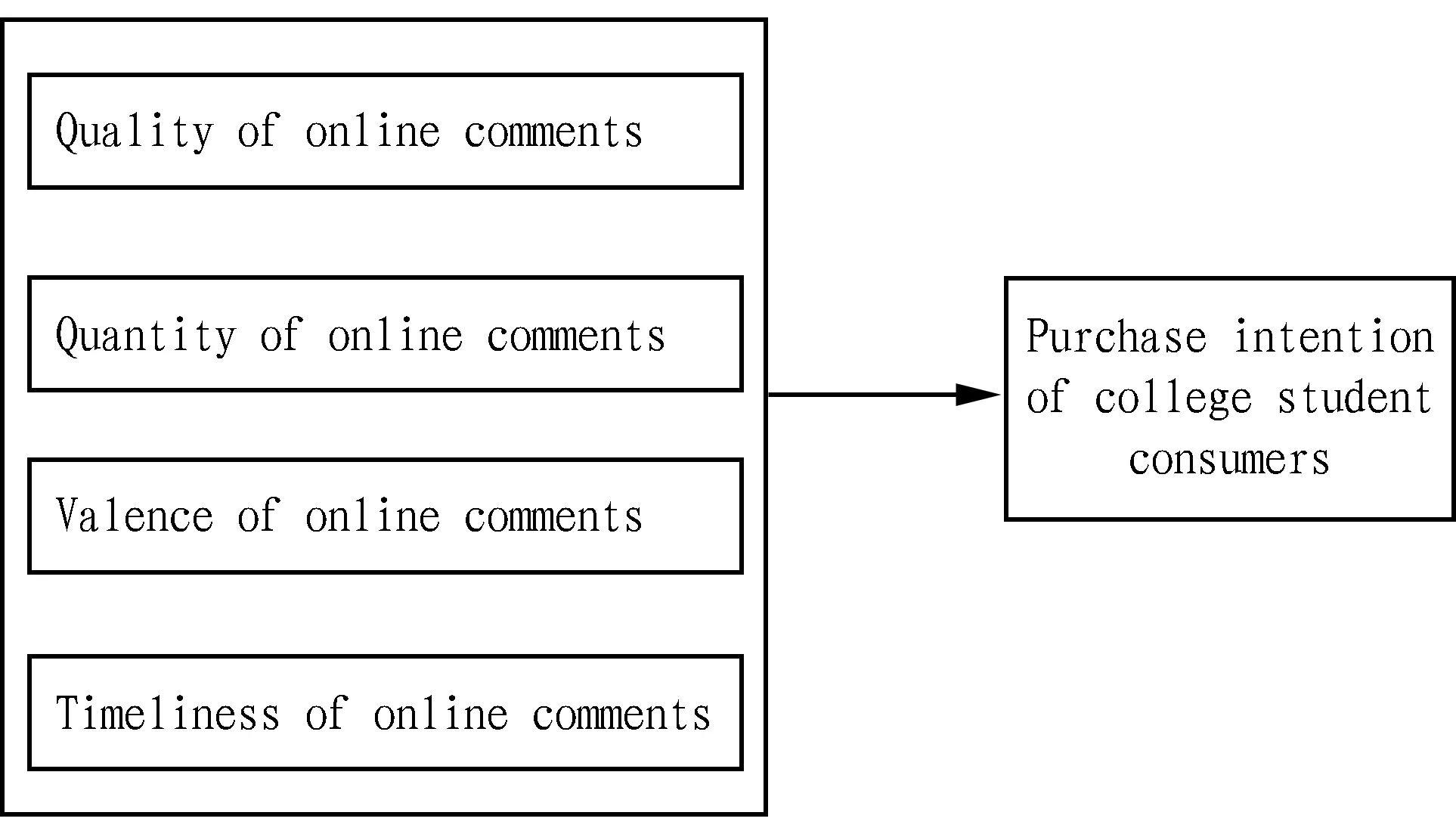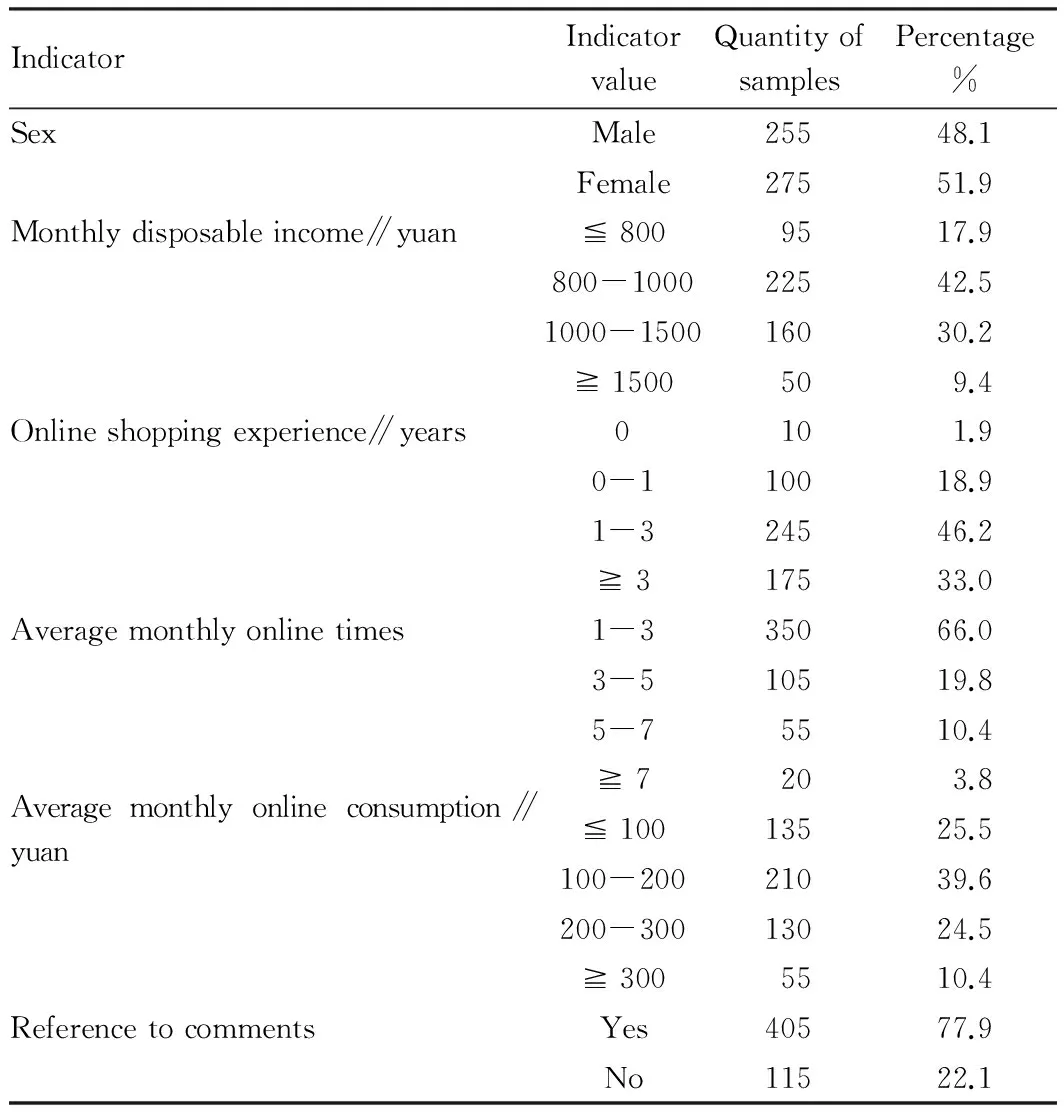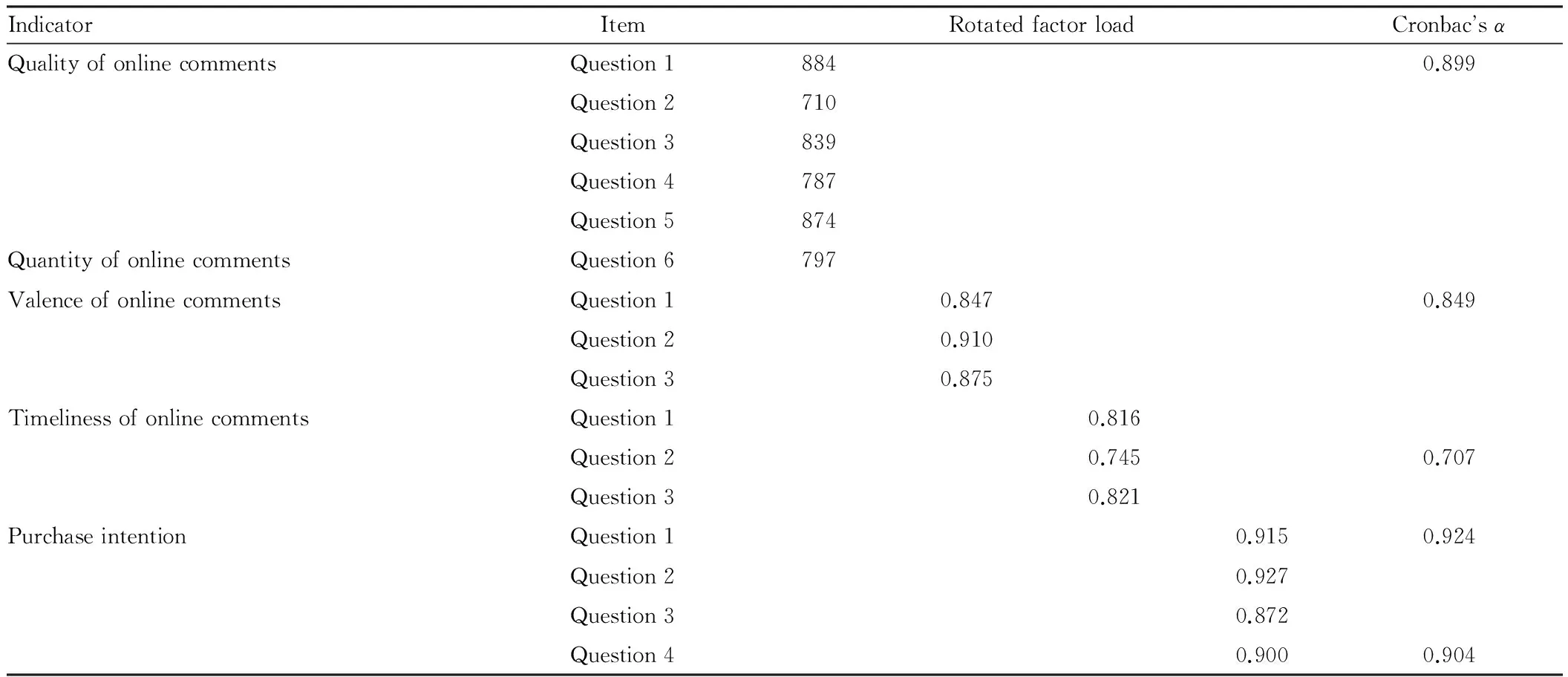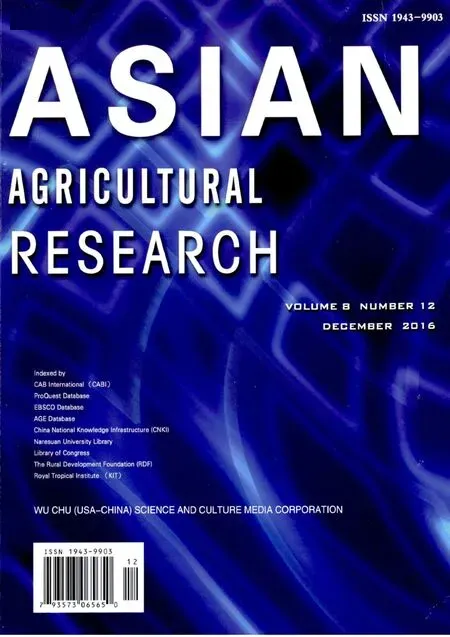Impact of Online Comments on Purchase Intention of College Student Consumers under Online Shopping
2016-01-12,,
, ,
1. College of Economics and Management, Huazhong Agricultural University, Wuhan 430070, China; 2. Hubei Rural Development Research Center, Wuhan 430070, China
1 Introduction
Domestic and foreign scholars have carried out extensive researches about online comments. Chrysanthos pointed out that the online feedback mechanism can effectively disseminate enterprise information and play an important role in management activities such as developing potential users, retaining frequent users, and building brand[1]; Duanetal. that the comment content is not important, what counts is the comment quantity[2]. From four dimensions of comments, namely, the quality of comment content, the credibility of commentators, the timeliness of the comments, and the quantity of comments, Zheng Xiaoping studied the impact of online comments and concluded that: the quality of the comment content, credibility of commentator, the quantity of comments have a great impact on purchase decision of consumers, while the timeliness of the comment exerts little influence on purchase decision of consumers[3]. According to research results of Qin Wu, the positive, quantity, form, and time of online comment are directly proportional to impulsive purchase intention of online shoppers[4].
Previous researches focused on three main factors, namely, characteristics of commentators, characteristics of online comments, and characteristics of receivers. However, there are few researches about the characteristics of the online comments, and less about the impact of online comments on the purchase intention of college student consumers. In this situation, we explored the impact of the quality, quantity, valence, and timeliness of online comments on the purchase intention of college students, so that the online shopping platform and companies will attach great importance to the characteristics of online comments and strengthen the management of online comment communities and the establishment of comment mechanism, so as to enrich the decision-making standards of online shopping. This study will enrich and deepen the theory of online comments, and test the applicability of online comment related theory in college students, and will have strong theoretical significance. Based on the discussion of the impact of online comments on the purchase intention of college students, we analyzed the characteristics of online comments and came up with improvement recommendations, which are favorable for consumers making shopping decisions and shopkeepers improving their products or services, thus it will have strong practical significance for consumers and shopkeepers.
2 Literature review
The rapid development of technology allows consumers to communicate with each other in a diversified way. Then, with the emergence of information technology, the online comment appeared with the Internet as communication media. Since Chatterjee proposed the concept of online comment, more and more scholars started to study online comments[5]. Brickart and Schindier stated that comments can be made in the form of online comment, mail package, and distributed e-mail system, one-to-one mail, instant messaging, and chat room, in which the online comment is the most important one[6]. Bickartetal. held that online comment is a platform for consumers to express their opinions[7]. Park and Zhai Likong further pointed out that there are positive and negative online comments[8, 9]. In the opinion of Liu Shunli, online comment is based on online shopping experience of consumers for goods and services they purchased[10].
The purchase intention of consumers is generally closely related to the final purchase decision, and the purchase intention can well predict subsequent purchase behavior. Domestic and foreign scholars defined the purchase intention from different perspectives. Dodds, Grewaletal, Schiffilla and Kanuk and Han Rui and Tian Zhilong contended that purchase intention is the subjective probability or probability of buying a product or brand[11, 12]. Fishbein, Engeletal. and Mullet stated that purchasing intention is the subjective purchase tendency of consumers and it can predict their consumption behavior[13-15]. In this study, we defined the purchase intention as the inclination degree of consumers to purchase a product or service.
Many domestic and foreign scholars have studied the impact of online comments on the purchase intention of consumers from different perspectives. Chatterjee argued that online comments have a positive effect on sales activity of enterprises[5]. Duanetal. believed that the content of customer comment is not important and what counts is the quantity of comments made by customers[2]. Chrysanthos pointed out that the online feedback mechanism can effectively disseminate enterprise information, and is conducive to management activities such as developing potential users, retaining frequent users, developing products, building brand building[1]. According to Nanetal. , consumers have different intention and ideas, so their comments are different and subjective, which may mislead consumers[16]. Domestic scholars Feng Jianyingetal. believed that the individual characteristics of consumers, external and internal clues of the product, and socio-economic factors will affect purchase intention of consumers[17]. Pan Yong and Kong Dong stated that the comment of the credibility of the e-commerce website will affect the choice of consumers[18]; Liu Yueyi said that the quantity of online comments, the quality of the first comment content, and the credibility of consumers exert a significant positive effect on purchase decision of consumers[19], while the impact of the timeliness of their comments is not high[3]. Zhou Jingjing further pointed out that the quality of the comments and the quantity will significantly influence consumer brand awareness and brand comment, and credibility of commentators will bring about the bandwagon effect[20]; the order of impact on brand decision-making is the credibility of commentators, the quantity of comments, the quality of comments, and the valence of comments, while the credibility of commentators has the greatest impact on cutting down the decision-making time. According to research results of Qin Wu[4], the positive, quantity, form, and time of online comment are directly proportional to impulsive purchase intention of online shoppers. According to existing researches, the purchase intention of consumers is mainly influenced from four main factors, namely, source of online comments, characteristics of commentators, characteristics of online comments, and characteristics of receivers. However, the above researches are mainly qualitative analysis, they lack quantitative analysis of college students, and the relevant literature also cares little about characteristics of online comments. Thus, we took online comments as a starting point to study the impact of online comments on purchase intention of consumers from four dimensions.
3 Research design and hypotheses
3.1BuildingoftheresearchmodelTaking online college student consumers as study objects, we studied the impact of online comments on the online purchase intention of college students from four aspects: the quality of online comments, the quantity of online comments, the valence of online comments, and the timeliness of online comments. We took these four factors as independent variables, and took the purchase intention of college student consumers as dependent variables. We built following theoretical model.

Fig.1Researchmodel
3.2ResearchhypothesesBased on the above analysis, we put forward the following hypotheses from the purpose of research and related theories:
The relation between the quality of online comments and the purchase intention: The quality of online comments refers to whether the comment content is real and reliable, whether they can provide other online shopping users with a lot of useful information, and the correlation between content and product of comment. The form of online comments refers to the detail, accuracy, relevance, completeness of comments, and appropriateness of the manner in which the information is provided. Since there are many similarities between the quality and the form of online comments, we combined them together and called them as the quality of online comments. Zheng Xiaoping pointed out higher quality comments will have higher impact on purchase decision of consumers[3], and Zhou Jingjing also stated that the quality of online comments positively affects brand cognition[20]. This indicates that the quality of online comments will have certain impact on the purchase intention. Therefore, we put forward following hypothesis:
H1The quality of online comments significantly affects purchase intention of college consumers.
The relation between the quantity of online comments and the purchase intention: Generally, the quantity of online comments is a signal of product popularity. Usually, consumers often consult the comments of others to reduce or even eliminate the risk when they do not fully know the product information. If there are more online comments, consumers will get more information, then they can understand the products to be purchased better, they will have higher purchase intention. Zheng Xiaoping[3]pointed out that the more online comments, the higher impact there will be on purchase decision of consumers. Therefore, we put forward following hypothesis:
H2The quantity of online comments significantly affects purchase intention of college consumers.
The relation between the valence of online comments and the purchase intention: The valence of online comments refers to whether the information delivered by online comments is positive or negative. The valence can be positive, negative or neutral. Both the positive and negative comments may affect the purchase intention of the consumers. Positive online comments will increase confidence of consumers in the product and enhance their purchase intention, while negative online comments can undermine confidence of consumer and lower their purchase intention. Zhou Jingjing held that the valence of online comments positively affects brand cognition[20], while Zhai Likong pointed out that negative online comments have a greater impact on purchase intention of consumers than positive online comments[9]. Therefore, we put forward following hypothesis:
H3The valence of online comments significantly affects purchase intention of college consumers.
The relation between the timeliness of online comments and the purchase intention: The timeliness of online comments refers to whether the information of online comments is new and whether the information update is timely. If the timeliness of online comments is different, the impact on purchase intention of consumers will be different. According to research of Zheng Xiaoping, the higher the timeliness of online comments, the greater impact they will exert on purchase decision of consumers[3]. Xiao Ling pointed out that the higher the timeliness of online comments, the lower the risk perceived by consumers[21]. Therefore, we put forward following hypothesis:
H4The timeliness of online comments significantly affects purchase intention of college consumers.
3.3Researchdesign
还是以郜艳敏事件为例。关于郜艳敏的新闻报道显然属于“一度区隔”,舆论有权对新闻文本的真实性问责。比如,2006年发布的《被拐女子曲阳书写园丁传奇》一文中报道,郜艳敏是在1994年遭到人贩子强暴后以2700元的价格卖到曲阳县灵山镇下岸村。这里所涉及到的人物、时间、地点以及郜艳敏被强暴和被拐卖的事实均直接指涉现实,不允许有任何虚构,因而新闻报道是“透明”的媒介再现。
3.3.1Collection of samples. In this study, we are intended to explore the inherent mechanism of the impact of online comments on purchase intention of college student consumers under online shopping, so we took students of colleges in Wuhan as objects of questionnaire. Copies of questionnaire were distributed and collected in colleges and www.sojump.com. In total, 600 copies of questionnaire were sent out, 550 copies were collected, and 530 copies were valid, the effective response rate was 88%.
3.3.2Description of variables. In this study, we mainly considered two variables: the online comments (the quality, quantity, valence, and timeliness) and the purchase intention. For the quality dimension, quantity dimension, valence dimension, and timeliness dimension, we mainly referred to Zheng Xiaoping[3], Zhou Jingjing[20], Wang Xiaoxu[22]and Qin Wu[4], respectively. On the basis of their researches, we made appropriate expansion and modification of specific indicators. For the measurement of purchase intention, domestic and foreign scholars set different measurement items. Berkowitz and Walton measured the purchase intention of consumers through directly asking whether they would buy the product[23], while Jiang Xiaodong measured the purchase intention of consumers according to the possibility of consumers buying fake products in the coming year[24]. With reference to 5 items (high possibility of purchase, worth purchasing, plan to purchase, recommend to others, and intended to purchase) proposed by Dodds, Monroe and Grewal, and Grewal and Krishman and 4 items (high possibility of purchase, keen to purchase, recommend to others, and as preferred choice) put forward by Yan Meng[25], we made appropriate alteration as necessary.
4 Empirical results and analyses
4.1BasiccharacteristicsofsamplesThe statistical results in Table 1 indicate that women accounted for the majority (51.9% of the total) and men were a few (48.1%), reflecting that women were slightly more than men in the online shopping community of college students. As to the monthly disposable income, 42.5% spent 800-1000 yuan, 30.2% spent 1000-1500 yuan, 17.9% spent less than 800 yuan, and 9.4% spent higher than 1500 yuan, reflecting that college students had relatively low disposable income due to no income source. As to the online shopping experience, 46.2% had 1-3 years and 33.0% had more than 3 years. For the times of monthly online shopping, 66.0% had 1-3 times, indicating that college students were relatively restrained in the online shopping. For the average monthly consumption of online shopping, 25.5% spent less than 100 yuan, 39.6% spent 100-200 yuan, and 24.5% spent 200-300 yuan, and most students spent below 300 yuan, which is consistent with the facts. As to the reference to the online comments, 77.9% students referred to online comments.
Table1Statisticsofdescriptivevariablesofsamples

IndicatorIndicatorvalueQuantityofsamplesPercentage%SexMale25548.1Female27551.9Monthlydisposableincome∥yuan≦8009517.9800-100022542.51000-150016030.2≧1500509.4Onlineshoppingexperience∥years0101.90-110018.91-324546.2≧317533.0Averagemonthlyonlinetimes1-335066.03-510519.85-75510.4≧7203.8Averagemonthlyonlineconsumption∥yuan≦10013525.5100-20021039.6200-30013024.5≧3005510.4ReferencetocommentsYes40577.9No11522.1
4.2ReliabilityandvalidityanalysisofthescaleIn order to find out the consistency and reliability of the questionnaire, we tested the reliability test for 4 dimensions of online comments. Test results (listed in Table 2) indicated that Cronbach’sαvalues of the quality of the online comments, the quantity of online comments, the valence of online comments, and the timeliness of online comments were 0.899, 0.849, 0.707, and 0.924 respectively. The Cronbach’s α in the model was greater than 0.7, indicating that the consistency of the model is high and the measurement results are reliable and stable. The cumulative explanation rate of factor analysis is up to 75.758%. From the rotated factor load and group, it can be seen that the factor load of each indicator is higher than 0.7 and the KMO value is 0.881. The Sig value of Bartlett sphericity test is 0.000 <0.01, very significant, reflecting that the goodness of fit is excellent and the validity of scale is high.
Table2Reliabilityandvaliditytestofvariables

IndicatorItemRotatedfactorloadCronbacsαQualityofonlinecommentsQuestion18840.899Question2710Question3839Question4787Question5874QuantityofonlinecommentsQuestion6797ValenceofonlinecommentsQuestion10.8470.849Question20.910Question30.875TimelinessofonlinecommentsQuestion10.816Question20.7450.707Question30.821PurchaseintentionQuestion10.9150.924Question20.927Question30.872Question40.9000.904
4.3CorrelationanalysisThe correlation analysis is to study the closeness of different variables and reveal the strength of statistical relationship between things. It is generally believed that when the absolute value of the Pearson coefficient is greater than 0.3 and the probabilityPof the test statistics is less than a given significance levelα(0.05), there is a significant correlation between the two variables. In this study, we used the common Pearson correlation analysis to test the relationship between 4 independent variables (the quality of online comments, the quantity of online comments, the valence of online comments, and the timeliness of online comments) and the dependent variable (purchase intention).
Table3Correlationbetweeninfluencingfactorsandpurchasedecision

InfluencingfactorsQualityQuantityValenceTimelinessPurchaseintentionPurchaseintentionPearsoncorrelation0.894**0.808**0.824*0.737**1QualityPearsoncorrelation10.770**0.782**0.729**0.894**QuantityPearsoncorrelation10.767**0.619**0.808**ValencePearsoncorrelation10.665**0.824**TimelinessPearsoncorrelation10.737**
Note:**denotes significance level of 0.01 (two-tailed), and*denotes significance level of 0.05 (two-tailed).
4.4RegressionanalysisThe correlation analysis can indicate if there exists correlation between factors, while the regression analysis can further analyze whether there is causal relationship between factors. Here, we applied the stepwise regression analysis method to study the causal relation between influencing factors and purchase intention.
Table4Goodnessoffittestfortheregressionmodel

ModelRR2AdjustedR2Estimatedstandarderror10.927a0.8590.8530.28398a.Predictivevariable:(constant),timeliness,quantity,valence,andquality
Table5Residualerroroftheregressionmodel

ModelSquaresumMeansquareFSig.Regression49.44912.320153.2880.0001Residualerror8.1450.081Total57.594
From Table 4 and Table 5, the adjusted coefficient of determination R2is 0.853, indicating that the regression equation is representative to a certain extent. The significance probability of the coefficient of determinationFbeing 153.288 is 0.000, reaching the significance level.
Table6Regressioncoefficientandsignificancetest

ModelNon-standardizedcoefficientBStandarderrorStandardizedcoefficientTrialeditiontSig.1(Constant)-0.0460.154--2.960.768Quality0.4960.0730.4936.8190.000Quantity0.1910.0640.1932.9880.004Valence0.2340.0740.2133.1730.002Timeliness0.0980.0470.1172.0840.040Sex0.0630.0560.0431.1200.265a.Dependentvariable:purchaseintention
From Table 6, the regression analysis of the quality, quantity, valence and timeliness of online comments to the dependent variable purchase intention is significant, and the significance probability ofβcoefficient of 4 variables is below 0.05. Theβcoefficient of the control variable sex is 0.265 > 0.05, which means no impact, so it should be excluded.
We obtained following regression equation:
The degree of purchase intention =- 0.046 + 0.496 quality + 0.191 quantity + 0.234 valence + 0.098 timeliness. According to data analysis results, we tested hypotheses and the test results are as follows:
H1(The quality of online comments significantly affects purchase intention of college consumers) holds true.
H2(The quantity of online comments significantly affects purchase intention of college consumers) holds true.
H3(The valence of online comments significantly affects purchase intention of college consumers) holds true.
H4(The timeliness of online comments significantly affects purchase intention of college consumers) holds true.
4.5ResultsThrough the analysis on descriptive statistics of the basic characteristics of samples, the results show that the sample data achieved the purpose of the study. Test results of reliability and validity indicate that they meet the study requirement. In this process, we tested the hypotheses with the aid of SPSS17.0 statistical software. The hypothesis test results are listed in Table 7.
Table7Resultsofhypothesistest

HypothesisConclusionThequalityofonlinecommentssignificantlyaffectspurchaseintentionofcollegeconsumersTrueThequantityofonlinecommentssignificantlyaffectspurchaseintentionofcollegeconsumersTrueThevalenceofonlinecommentssignificantlyaffectspurchaseintentionofcollegeconsumersTrueThetimelinessofonlinecommentssignificantlyaffectspurchaseintentionofcollegeconsumersTrue
5 Conclusions and recommendations
5.1ConclusionsTaking online college student consumers as study objects, we studied the impact of online comments on the online purchase intention of college students from four factors: the quality of online comments, the quantity of online comments, the valence of online comments, and the timeliness of online comments. Taking the purchase intention of college students as dependent variables, we carried out regression analysis. We concluded that the quantity, quality, valence and timeliness of online comments exert a significant impact on the purchase intention of college student consumers.
5.2Recommendations(i) Online shopping platforms should fully improve their online comment mechanism. With the advent of the information era, the volume of information that people are exposed to becomes larger, and people will always face problems difficult to make decisions. In addition to the information asymmetry between shops and consumers in online shopping, the mechanism that can help consumers making decision becomes particularly important. Although the current online shopping platforms have established the online comment mechanism, it still needs to be further improved. Take the largest online shopping platform C2C - Taobao as an example, consumers may comment on product quality, service, and can make additional comment, but other consumers can not comment on those comments, shops may forge comments. Therefore, online shopping platform should continue to improve the online comment mechanism, to promote consumers to make scientific decision-making of purchase, so as to bring large volume of sales to the online shopping platform. (ii) Shops should strengthen the management of the community of online comments. They should seriously and actively respond to consumer comments, take incentive measures to improve the quality of online comments, encourage consumers to update comments and make positive comments, such as offer a certain amount of discounts, shop coupons, points for products, and gifts, in order to serve customers better and also help shops to improve customer satisfaction and loyalty, and stimulate the purchase intention of college students. (iii) College students should reasonably and effectively use online comments during online shopping. As college student consumers, they have high ability of expressing their ideas, so they should make high-quality, clear-cut, timely and effective comments as much as possible, to help other consumers make correct decisions. This study is expected to provide certain guidance for college student consumers. During online shopping, they may take online comments as reference, and pay attention to the quality, quantity, valence and timeliness of online comments, to help themselves make correct shopping decision.
[1] CHRYSANTHOS D. The digitization of word of mouth: promise and challenges of online feedback mechanisms [J]. Management Science, 2003, 49(10): 1407-1424.
[2] DUAN W, GU B, WHINSTON AB. Do online reviews matter: An empirical investigation of panel data [J]. Decision Support Systems, 2008, 45 (4): 1007-1016.
[3] ZHENG XP. An empirical study of the impact of online review on Internet consumer purchasing decision[D]. Beijing: Renmin University of China, 2008. (in Chinese).
[4] QIN W. Study on the influence mechanism of online reviews on online consumers’ impulse buying intent [D].Wuhan: Huazhong University of Science and Technology, 2009. (in Chinese).
[5] CHATTERJEE P. Online reviews do consumers use them[J]. Advances in Consumer Research, 2001, 28:129-133.
[6] BICKART B, SCHINDLER RM. Internet forums as influential sources of consumer information [J]. Journal of Interactive Marketing, 2001, 15(3): 31-40.
[7] LEE J, PARK DH, HAN I. The effect of negative online consumer reviews on product attitude: An information processing view [J]. Electronic Commerce Research and Applications, 2008, 7(3): 341-352.
[8] PARK DH, KIM S. The effects of consumer knowledge on message processing of electronic word of mouth via online consumer reviews [J]. Electronic Commerce Research and Applications, 2008, 7(4): 399-410.
[9] ZHAI LK. Research on the effect of online consumer review on purchasing intention [D]. Dalian: Dongbei University of Finance and Economics, 2011. (in Chinese).
[10] LIU SL. An empiricial study on the influence of online comments on online bookstores’ sales volume [D]. Changsha: Hunan University, 2013. (in Chinese).
[11] DODDS WB, MONROE KB,etal. Effects of price, brand, and store information on buyers’ product evaluations [J]. Journal of Marketing Research, 1991,28(3): 307-319.
[12] HAN R, TIAN ZL. Effects of alternative promotion types on consumers’ value perception and purchase intentions [J].Management Sciences in China, 2005(2): 85-91. (in Chinese).
[13] FISHBEIN M, AJZEN I. Belief, attitude, intention, behavior: An introduction to theory and research [M]. Reading, MA: Addison-Wesley,1975.
[14] ENGLE JE, BLACKWELL RD, MINIARD PW. Consumer behavior [M].Chicago: The Dryden Press, 1993.
[15] MNLLET GM, KARSON MJ. Analysis of purchase intent scales weighted by probability of actual purchase [J]. Journal of Marketing Research,1985(2):35-42.
[16] NAN H, PAUL A, ZHANG PJ. Can online reviews reveal a product’s true quality: Empirical findings and analytical modeling of online word-of-mouth communication [Z]. In: Proceedings of the 7th ACM Conference on Electronic Commerce, New York, 2006: 324-330.
[17] FENG JY, MU WS, FU ZT. Research overview on consumers’ purchase intention [J]. Modern Management Science, 2006(11): 7-9. (in Chinese).
[18] PAN Y, KONG D. A research on estimation of credible degree of electric commerce website [J]. Journal of Intelligence, 2007(7): 81-82, 87. (in Chinese).
[19] LIU YY. An empirical study of the impact of online review on Internet consumer purchasing decision [D]. Nanchang: Jiangxi University of Finance and Economics, 2014. (in Chinese).
[20] ZHOU JJ. The study of online cosumer reviews Impact on consumers purchasing decision [D]. Hangzhou: Zhejiang University, 2009. (in Chinese).
[21] XIAO L. Study on the influence of online comments on risk perception in the shopping online process [D]. Cnetral South University, 2012. (in Chinese).
[22] WANG XX, WANG HQ. Study on the influence of online comments on online consumers’ purchase intension [J]. Oriental Enterprise Culture, 2013(5): 106. (in Chinese).
[23] BERKOWITZ EN, WALTON JR. Contextual influences on consumer price responses: An experimental analysis [J]. Journal of Marketing Research,1980, 17(3):349-359.
[24] JIANG XD, YAO H, CHAO GL. The effect of consumers’ perceived risk, materialism and ethical ideology on their intention to purchase luxury counterfeits [J]. Economic Management, 2009(12): 103-108. (in Chinese).
[25] YAN M. Research on the influence of Internet word-of-mouth on college students’ purchase intention [D]. Wuhan: Huazhong University of Science and Technology, 2011. (in Chinese).
猜你喜欢
杂志排行
Asian Agricultural Research的其它文章
- Shanghai "Maker" Urban Culture Construction in the Context of Big Cloud Movement
- Realistic Meaning of Agricultural Crisis Theory of Marx and Engels
- Current Situation and Mental Health and Intervention Measures of Left-behind Children
- Analysis on Development of Rural Financial Management Informationization
- Survival Predicament and Recommendations for Second Generation Farmers in Northwest China
- Problems in Development of Rural E-commerce and Logistics and Recommendations
